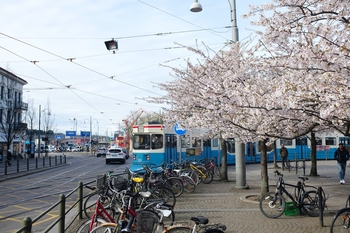Can the green transition make the labour market more equal?

Fra venstre: Emma Holten, Emil Fannikke Kiær, Emanuela Pozzan, Monsterrat Mir, Tadashi Matsumoto og moderator Chika Oduah.
From the left: Emma Holten, Emil Fannikke Kiær, Emanuela Pozzan, Montserrat Mir, Tadashi Matsumoto and moderator Chika Oduah.
Gender equality and a fair transition were high on the agenda at the COP27 talks in Sharm el-Sheikh, and 14 November was “Gender Day”. Women continue to bear a disproportionately large burden of the adverse effects of climate change. Greater efforts need to be made in order to fully integrate the gender perspective into climate policy.
The green transition will have major implications for the labour market. According to International Labour Organization (ILO) data from 2018, around six million jobs could be lost in the shift from a fuel-based economy to a carbon-neutral one. However, at the same time, the transition also offers many opportunities — the ILO data suggests that as many as 24 million new jobs could be created. The transition also presents challenges when it comes to ensuring a gender-balanced and sustainable labour market in the future.
The green transition provides opportunities to transform the world of work. During the debate in the Nordic Pavilion, experts from the international organisations ILO, the International Trade Union Confederation (ITUC) and the OECD, along with a Nordic business leader and an activist, gathered to discuss gender equality, working life and the green transition.
What are green jobs?
“We need to take the conversation about fair transition and green jobs to the next level. We must go beyond the traditional understanding of what green jobs are, and the sectors we traditionally consider green, and start thinking of care work as green work,” said Emanuela Pozzan, Senior Gender Specialist at the ILO.
Pozzan and Danish feminist activist Emma Holten opened the debate by urging us to rethink green jobs and sectors. Holten emphasised the importance of appreciating the cultural and economic value of care work, in order to ensure a sustainable society in the future:
Care work is that amazing thing – an almost climate-neutral sector.
ILO defines green jobs as ones associated with the conservation or restoration of the environment, whether in traditional sectors such as manufacturing and construction, or in new and emerging green sectors such as renewable energy, recycling and energy efficiency.
A gender segregated labour market
Tadashi Matsumoto of the OECD summarised the key findings of the forthcoming report Job Creation and Local Economic Development: Going Green. According to the report, around 17% of jobs in OECD countries can be classed as “green”. Of these, 72% are done by men, and only 28% by women. In addition, wages for green jobs are on average 20% higher than for non-green ones. “The report illustrates the inequity in what we conventionally consider to be the green sector,” Matsumoto said, after presenting the figures.
Montserrat Mir, Special Adviser at the ITUC Just Transition Centre, believes that this may be due to the tendency to echo the gender-segregated labour market in the green transition.
“We’re trying to move the workforce from the most polluting sectors, like oil, gas and coal, the vast majority of whom are men, to sustainable technology sectors. But in doing so, we’re reproducing the gender sex-segregated labour market in the green transition,” she explained.
The green shift will cost – but also create – many jobs
The Confederation of Danish Industry (DI) is focusing on encouraging more women to enter the green technology sector. “The work of making technological education more attractive to women begins in kindergarten and in schools,” said Emil Fannikke Kiær, Deputy Director General at DI.
However, the issue of gender equality in the labour market is not only a matter of including women.
“We have talked about how we need more women in STEM (Science, Technology, Engineering, Mathematics) and green transition jobs, but I think we need to envisage a future in which many more men are working in the care sector,” said Emma Holten.
“It’s true that if we look at green jobs in a traditional way, the ILO estimated 24 million new jobs. However, if we look at the care sector, and how we meet the needs of society, proper investment could generate 300 million jobs by 2035,” said Emanuela Pozzan.
Interested in the future of working life?



